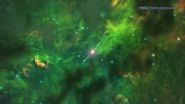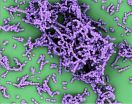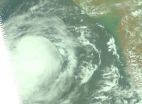(Press-News.org) Using the Atacama Large Millimeter/submillimeter Array (ALMA), a team of researchers reports the first-ever detection of molecular gas -- the fuel for star formation -- in two galaxies that were previously rocked by gamma ray bursts (GRBs), the brightest explosions in the Universe. These new observations revealed that the molecular gas was concentrated toward the centers of the galaxies, while the GRBs occurred in unusual environments that were surprisingly bereft of gas yet rich in dust.
The researchers speculate that the dearth of molecular gas around the GRBs was due to strong ultraviolet (UV) radiation from young, massive stars, which can break apart the molecules of gas while leaving the dust relatively undisturbed.
The GRBs, dubbed GRB 020819B and GRB 051022, are located approximately 4.3 billion and 6.9 billion light-years away from Earth, respectively.
Astronomer Bunyo Hatsukade, assistant professor at the Chile Observatory of the National Astronomical Observatory of Japan (NAOJ), led the research group that studied the GRB host galaxies. The results are published in the journal Nature.
ALMA's unprecedented sensitivity made it possible to make the first detection ever of carbon monoxide (CO) gas in a GRB host galaxy. ALMA's unparalleled high resolution also revealed GRB 020819B occurred in a galaxy where the molecular gas was concentrated at the nuclear region while dust was concentrated at the site of the GRB. The ratio of dust to molecular gas at the GRB site is ten or more times higher than in normal environments. It is the first time that the spatial distribution of molecular gas and dust in the GRB host galaxies is revealed.
Currently, GRBs are classified as either long- or short-duration. A long-duration GRB, which lasts two seconds or longer, is believed to be generated by the supernova explosion of a star 40 or more times the mass of our Sun. Short GRBs last less than two seconds and are associated with the collision and merger of neutron stars.
Previously, astronomers believed that massive stars that give rise to GRBs would reside in active star forming regions surrounded by a large amount of molecular gas. However, there had been no observation of molecular gas emission from any GRB host galaxy, which was a longstanding mystery.
"We have been searching for molecular gas in GRB host galaxies over 10 years since 2003 using various telescopes around the world such as Nobeyama Millimeter Array in Japan, Plateau de Bure Interferometer (PdBI) in France, and the ASTE Telescope in Chile," said Kotaro Kohno, a professor at the University of Tokyo and a member of the research team. "As a result of our hard effort, we finally achieved a remarkable breakthrough using ALMA with unprecedentedly high sensitivity. We are very excited with what we have achieved."
The sensitivity of ALMA was about five times better than the earlier observations, even though the ALMA observations were conducted in only 47 minutes as part of the early science campaign with just a fraction of the telescope's eventual full complement of 66 antennas.
"We didn't expect that GRBs would occur in such a dusty environment with such a low fraction of molecular gas. This indicates the GRB occurred in an unusual environment," says Hatsukade.
The research team believes that the GRB sites were surrounded initially by a large quantity of molecular gas and dust, which fueled intense star formation.
While molecular gas is easily disintegrated by strong UV rays emitted by newly formed massive stars, dust is less susceptible. These different reactions could explain the spatial distribution of molecular gas seen in the recent ALMA observations.
"The results obtained this time were beyond our expectations. We need to carry out further observations with other GRB hosts to see if this could be general environmental conditions of a GRB site. We are looking forward to future research with the improved capability of ALMA," says Hatsukade.
"Gamma ray bursts are among the most extreme and tantalizing objects in all of physics and astronomy," said Kartik Sheth, an astronomer at the National Radio Astronomy Observatory in Charlottesville, Va. "These new observations offer an unprecedented view of the GRB environment and suggest important new avenues of research that are within ALMA's grasp."
INFORMATION:
The Atacama Large Millimeter/submillimeter Array (ALMA), an international astronomy facility, is a partnership of Europe, North America and East Asia in cooperation with the Republic of Chile. ALMA is funded in Europe by the European Southern Observatory (ESO), in North America by the U.S. National Science Foundation (NSF) in cooperation with the National Research Council of Canada (NRC) and the National Science Council of Taiwan (NSC) and in East Asia by the National Institutes of Natural Sciences (NINS) of Japan in cooperation with the Academia Sinica (AS) in Taiwan. ALMA construction and operations are led on behalf of Europe by ESO, on behalf of North America by the National Radio Astronomy Observatory (NRAO), which is managed by Associated Universities, Inc. (AUI) and on behalf of East Asia by the National Astronomical Observatory of Japan (NAOJ). The Joint ALMA Observatory (JAO) provides the unified leadership and management of the construction, commissioning and operation of ALMA.
The National Radio Astronomy Observatory is a facility of the National Science Foundation, operated under cooperative agreement by Associated Universities, Inc.
Gigantic explosion buried in dust: ALMA probes environment around gamma ray bursts
2014-06-11
ELSE PRESS RELEASES FROM THIS DATE:
Breakthrough study sheds new light on best medication for children with seizures
2014-06-11
DETROIT – A recently published clinical study in the Journal of the American Medical Association has answered an urgent question that long puzzled ER pediatricians: Is the drug lorazepam really safer and more effective than diazepam – the U.S. Food and Drug Administration-approved medication as first line therapy most often used by emergency room doctors to control major epileptic seizures in children?
The answer to that question – based on a double-blind, randomized clinical trial that compared outcomes in 273 seizure patients, about half of whom were given lorazepam ...
Why aren't product designers considering activity trackers for older adults?
2014-06-11
Commercially available activity-monitoring apps, Web sites, and wearable devices allow for easy self-management of health and wellness. This technology may be particularly helpful for older adults, who can improve their cognitive function through proper diet and exercise. Despite tracking monitors' growing popularity and potential benefits, product designers rarely consider those over 65 to be a viable user group, and new human factors/ergonomics research indicates that the technology presents several usability challenges for this population.
"Many older adults have ...
A key step toward a safer strep vaccine
2014-06-11
An international team of scientists, led by researchers at the University of California, San Diego School of Medicine, have identified the genes encoding a molecule that famously defines Group A Streptococcus (strep), a pathogenic bacterial species responsible for more than 700 million infections worldwide each year.
The findings, published online in the June 11 issue of Cell Host & Microbe, shed new light on how strep bacteria resists the human immune system and provides a new strategy for developing a safe and broadly effective vaccine against strep throat, necrotizing ...
A NASA view of Tropical Cyclone Nanauk in the Arabian Sea
2014-06-11
Tropical Cyclone 02A has consolidated and strengthened over a 24 hour period between June 10 and 11 and an image from NASA's Aqua satellite showed a more rounded tropical storm, despite wind shear.
As Tropical Cyclone 02A consolidated and strengthened into a tropical storm it was re-named Nanauk. NASA's Aqua satellite passed over Nanauk on June 11 at 08:29 UTC (4:29 a.m. EDT) and the Atmospheric Infrared Sounder (AIRS) captured an infrared and near-infrared image of the storm. The near-infrared image provided an almost visible look at the clouds that revealed a well-rounded ...
Gum disease bacteria selectively disarm immune system, Penn study finds
2014-06-11
The human body is comprised of roughly 10 times more bacterial cells than human cells. In healthy people, these bacteria are typically harmless and often helpful, keeping disease-causing microbes at bay. But, when disturbances knock these bacterial populations out of balance, illnesses can arise. Periodontitis, a severe form of gum disease, is one example.
In a new study, University of Pennsylvania researchers show that bacteria responsible for many cases of periodontitis cause this imbalance, known as dysbiosis, with a sophisticated, two-prong manipulation of the human ...
Migrating north may trigger immediate health declines among Mexicans
2014-06-11
PRINCETON, N.J.—Mexican immigrants who relocate to the United States often face barriers like poorly paying jobs, crowded housing and family separation. Such obstacles – including the migration process itself – may be detrimental to the health of Mexican immigrants, especially those who have recently moved.
A study led by Princeton University's Woodrow Wilson School of Public and International Affairs finds that Mexican immigrants who relocate to the United States are more likely to experience declines in health within a short time period compared with other Mexicans. ...
New study finds Internet not responsible for dying newspapers
2014-06-11
We all know that the Internet has killed the traditional newspaper trade, right? After all, until the general population started interacting with the web in the mid-90s, the newspaper business was thriving—offering readers top notch journalism and pages of ads.
But a recently-published study finds that we may be all wrong about the role of the Internet in the decline of newspapers.
According to research by University of Chicago Booth School of Business Professor Matthew Gentzkow, assumptions about journalism are based on three false premises.
In his new paper, "Trading ...
Study shows Deepwater Horizon crude oil impairs swimming performance of juvenile mahi-mahi
2014-06-11
VIDEO:
This shows juvenile Mahi-mahi in swim tunnel, which allows scientists to monitor metabolic rate swim performance.
Click here for more information.
MIAMI – A new study led by University of Miami (UM) Rosenstiel School of Marine and Atmospheric Science scientists showed up to a 37% decrease in overall swimming performance of Deepwater Horizon oil-exposed juvenile mahi-mahi. The findings reveal the toxic effects of crude oil on ecologically and commercially valuable fish ...
Survey: Almost all adult Texans knew about Health Insurance Marketplace during open enrollment
2014-06-11
HOUSTON – (June 11, 2014) – Almost all adult Texans were aware of the Affordable Care Act's Health Insurance Marketplace before the open-enrollment period ended March 31, according to a report released today by Rice University's Baker Institute for Public Policy and the Episcopal Health Foundation.
The report also found that an estimated 2 million Texans looked for information about the Marketplace and found the federal healthcare.gov website generally helpful. Almost half of Texans who visited the site wanted to purchase insurance or check their eligibility for a ...
White bread helps boost some of the gut's 'good' microbes
2014-06-11
White-bread lovers take heart. Scientists are now reporting that this much-maligned food seems to encourage the growth of some of our most helpful inhabitants — beneficial gut bacteria. In addition to this surprising find, their study in ACS' Journal of Agricultural and Food Chemistry also revealed that when looking at effects of food on our "microbiomes," considering the whole diet, not just individual ingredients, is critical.
Sonia González and colleagues note that the bacteria in our guts, or our microbiome, play an important role in our health. When certain populations ...








